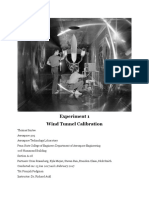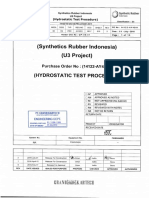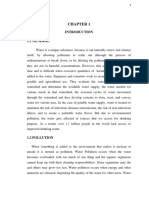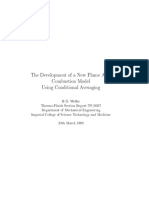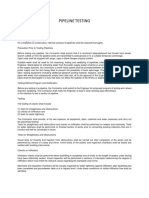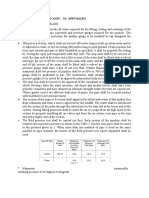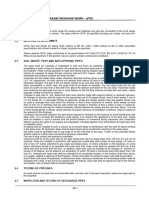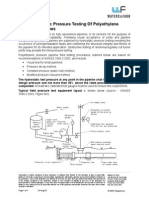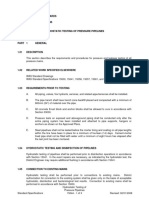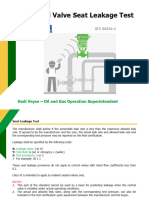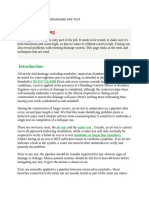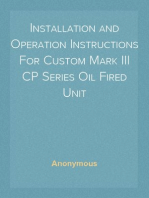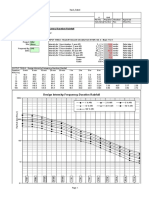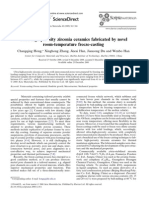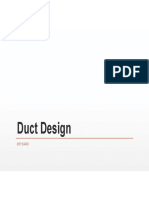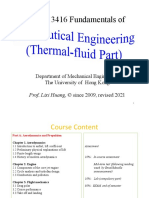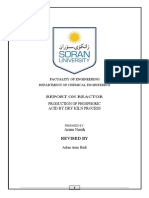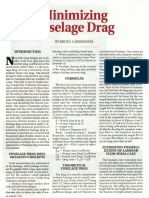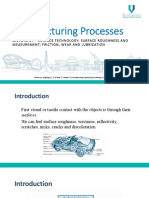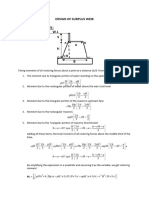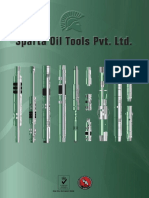Section 3810 - Gravity Sewer Leakage Tests Part 1 - General 1.1 Scope of Work
Section 3810 - Gravity Sewer Leakage Tests Part 1 - General 1.1 Scope of Work
Uploaded by
Jong Dollente Jr.Copyright:
Available Formats
Section 3810 - Gravity Sewer Leakage Tests Part 1 - General 1.1 Scope of Work
Section 3810 - Gravity Sewer Leakage Tests Part 1 - General 1.1 Scope of Work
Uploaded by
Jong Dollente Jr.Original Title
Copyright
Available Formats
Share this document
Did you find this document useful?
Is this content inappropriate?
Copyright:
Available Formats
Section 3810 - Gravity Sewer Leakage Tests Part 1 - General 1.1 Scope of Work
Section 3810 - Gravity Sewer Leakage Tests Part 1 - General 1.1 Scope of Work
Uploaded by
Jong Dollente Jr.Copyright:
Available Formats
Revised: 2/27/2003 Section 3810 - Page 1
Effective: 7/17/2006
SECTION 3810 - GRAVITY SEWER LEAKAGE TESTS
PART 1 - GENERAL
1.1 SCOPE OF WORK:
Provide all labor, materials, equipment and services required for gravity sewer leakage testing specified herein.
PART 2 - EXECUTION
2.1 GRAVITY SEWER TESTING - LEAKAGE:
All completed piping shall be tested as specified herein by low-pressure air test, exfiltration, or infiltration test
after backfilling to test for leaks. The maximum leakage allowance for all sanitary sewers shall be 50 gallons
per inch diameter per mile of pipe per 24 hours. If the level of the current prevailing groundwater is two feet
(2') or more above the top of the sewer pipe, an infiltration test will be required. At the request of the
ENGINEER, a low-pressure air test or exfiltration test will be performed instead of or in addition to an
infiltration test if the ground water level is uncertain. Labor, equipment and supplies required for all tests shall
be furnished by the CONTRACTOR. The CONTRACTOR shall flush and clean the sewer line to the
satisfaction of the OWNER prior to testing. The ENGINEER shall witness and approve all leakage tests. In the
event that the CONTRACTOR performs any test without witness by the ENGINEER, the CONTRACTOR will
be required to test the section again at no cost to the OWNER. The CONTRACTOR and ENGINEER shall
sign all test reports. Note that only four sections (approximately 1,200 - 1,600 feet) of sewer will be permitted
to remain untested at any time.
A. Low Pressure Air Test:
After backfilling, the air test shall be conducted between two consecutive manholes. Low pressure air
tests shall be in accordance with ASTM C 924 for concrete pipe or F 1417 for plastic pipe, except as
specified otherwise herein. All pipe outlets must be plugged in the section being tested with suitable
test plugs. One of the plugs used at a manhole must be tapped and equipped for an air inlet connection
for filling the line from the air compressor.
Air shall be supplied slowly to the test section until the internal pressure reaches approximately 4
pounds per square inch (psi). At least 2 minutes shall be allowed for the air pressure to stabilize.
When the pressure has stabilized and is at or above 3.5 psi, the air supply shall be disconnected and
timing shall begin. Timing shall continue until the pressure has dropped 1.0 psi. If the time elapsed
before the pressure drops 1.0 psi is greater than the specified minimum holding time, the section shall
be considered to have passed the test. If the time is less than the specified minimum holding time, the
section shall be considered to have failed and must be repaired or replaced.
Minimum Holding Time shall be calculated from the following equation:
Holding Time (minutes) = 0.00037 x D
2
x L / Q
where D =Pipe Diameter (inches)
L =Length of Pipe Tested (feet)
Q =Allowable Air Loss (ft
3
/min) from Table B.2.
An air pressure correction is necessary when the current prevailing groundwater is above the invert of
the sewer line being tested. Under this condition, the air test pressure shall be increased 0.433 psi for
each foot the groundwater level is above the invert of the pipe. All gauge pressures shall be increased
by this amount. If the current prevailing groundwater is more than 27 inches above the invert of the
pipe, the infiltration or exfiltration test should be used as required above. Thus, internal air pressures
should never exceed 5.0 psi.
Revised: 2/27/2003 Section 3810 - Page 2
Effective: 7/17/2006
Table B.1. Minimum Holding Time for Low
Pressure Air Test
Nominal Pipe Size, in.
Time per 100 ft.
6
42 seconds
8
1 minute-12 seconds
10
1 minute-30 seconds
12
1 minute-48 seconds
15
2 minutes-6 seconds
18
2 minutes-24 seconds
21
3 minutes
24
3 minutes-36 seconds
27
4 minutes-12 seconds
30
4 minutes-48 seconds
33
5 minutes-24 seconds
36
6 minutes
Table B.2. Allowable Air Loss for Low Pressure
Air Test
Nominal Pipe Size, in.
Air Loss (Q), ft
3
/min
6 and 8
2
10
2.5
12
3
15
4
18
5
21
5.5
24
6
27
6.5
30
7
33
7.5
36
8
42
9
48
10
54
11
60
12
66
13
72
14
B. Infiltration Test:
The CONTRACTOR may elect to use an infiltration test when the level of the current prevailing
groundwater is two feet (2') or more above the top of the sewer pipe, including all service laterals, at
the highest point of the section being tested. The inlet end(s) of the upstream manhole shall be
securely sealed. The downstream sewer shall be completed and open to allow the sewer to drain. The
ENGINEER shall approve the length of sewer to be tested at one time. The ENGINEER may require
that each manhole span be tested separately. The amount of infiltration shall be measured by means of
a weir located in the downstream manhole. The test head shall be maintained for a period of at least
24 hours before the weir measurement is made. Infiltration shall not exceed 50 gallons per inch
diameter per mile of pipe per 24 hours. This infiltration test may not be performed until the sewer line
and manholes are completed and all known leaks are repaired. The CONTRACTOR will be required
to correct all conditions that permit visible infiltration and may be required to relay sections with such
conditions that cannot be corrected, even though infiltration is within allowable limits.
C. Exfiltration Test:
When the exfiltration test is selected, the inlet ends of the upstream and downstream manholes shall be
sealed with watertight plugs or bulkheads, and the sewer along with the upstream manhole shall be
filled with water until the elevation of the water in the upstream manhole is: 1) two feet (2') higher
than the top of the sewer pipe, including all service laterals, at the highest point of the section being
tested, or 2) two feet (2') above the level of the current prevailing groundwater, whichever is the higher
elevation. The test level shall be clearly marked in the upstream manhole. The entire length of section
to be tested shall be filled and maintained full of water for a period of at least 24 hours prior to the
start of the test. If the water level in the upper manhole drops during this 24 hour period, the level
shall be raised to the test level mark prior to start of the test. Exfiltration will be determined by
measuring the amount of water required to maintain the marked water level for a period of 1 hour from
the start of the test. The allowable leakage of 50 gallons per inch diameter per mile of pipe per 24
Revised: 2/27/2003 Section 3810 - Page 3
Effective: 7/17/2006
hours is based on a maximum difference in elevation of 8 feet between the water level in the upstream
manhole and the invert of the pipe being tested in the lower manhole or the current prevailing
groundwater level, whichever is higher. If this difference in elevation exceeds 8 feet, the allowable
leakage shall be increased 5 percent for each 1 foot in excess of 8 feet. All observed leaks shall be
corrected even if exfiltration is within the allowable limits.
D. Smoke Testing:
Smoke testing may be used only to locate leaks and in no case shall be considered conclusive. In all
cases the smoke test shall be accompanied by an air test, exfiltration test or infiltration test. The
ENGINEER may order a smoke test if another leakage test fails and the source of the leak cannot be
determined by other means. Smoke testing may only be performed where ground water is low and the
conduit is properly sealed. Smoke shall be blown into a sealed section of sewer under pressure, and
the CONTRACTOR and ENGINEER shall observe for any smoke appearing on top of the ground
indicating the presence of leaks. The ENGINEER may require that the CONTRACTOR excavate the
sewer to determine the source of any smoke appearing during a smoke test. All leaks or breaks
discovered by the smoke tests shall be repaired and/or corrected by the CONTRACTOR at his own
expense in a manner acceptable to the ENGINEER. Equipment and supplies required for smoke tests
shall be furnished by the CONTRACTOR. Smoke tests may be performed by the CONTRACTOR at
any time during construction at his option; however, any such tests shall not supplant the final tests of
the completed work.
PART 3 - BASIS OF PAYMENT
Testing of gravity sewers for leakage is not a pay item.
END OF SECTION
You might also like
- Pre-Commissioning and CommissioningDocument9 pagesPre-Commissioning and CommissioningSaurabh Sharma100% (7)
- Wind Tunnel Calibration Lab Report - Thomas SanteeDocument15 pagesWind Tunnel Calibration Lab Report - Thomas Santeeapi-354954173100% (2)
- Method of Statement For Hydrostatic TestingDocument6 pagesMethod of Statement For Hydrostatic TestingHalil Güney100% (2)
- Hydrostatic Test Procedure Storage TankDocument15 pagesHydrostatic Test Procedure Storage TankYuwantoniAl80% (5)
- Smacna Duct Leakage TestDocument3 pagesSmacna Duct Leakage TestGramniv Matthew67% (3)
- Construction Procedure For HydrotestingDocument7 pagesConstruction Procedure For HydrotestingEddie Tai100% (1)
- CPAA Field Testing of Concrete Pipelines and JointsDocument12 pagesCPAA Field Testing of Concrete Pipelines and JointsSameh BelalNo ratings yet
- Water Treatment PlantDocument56 pagesWater Treatment PlantPiriyangan B100% (2)
- Gas Lift PresentationDocument242 pagesGas Lift PresentationRonald PrietoNo ratings yet
- Tutorial: Using The Eulerian Multiphase Model With Species TransportDocument25 pagesTutorial: Using The Eulerian Multiphase Model With Species TransportNgô Ích SơnNo ratings yet
- Weller B Xi Combustion Model PDFDocument60 pagesWeller B Xi Combustion Model PDFWesley CalebNo ratings yet
- 12a. Introduction To Steam BoilersDocument17 pages12a. Introduction To Steam BoilersDr. BIBIN CHIDAMBARANATHANNo ratings yet
- SECTION 02660 Pipeline Testing: Hcss 02660-1 June 2008Document8 pagesSECTION 02660 Pipeline Testing: Hcss 02660-1 June 2008moyassine7139No ratings yet
- 330130Document7 pages330130Cool SharyNo ratings yet
- MWWSSB 11 Sewer TesRTRting and InpectionDocument5 pagesMWWSSB 11 Sewer TesRTRting and InpectionZeeshan ShaikNo ratings yet
- Pipeline TestingDocument4 pagesPipeline Testingveljko2008100% (1)
- Hdpe TUBI TestDocument6 pagesHdpe TUBI TestИван МинчевNo ratings yet
- Annex1 - Technical Specifications PDFDocument64 pagesAnnex1 - Technical Specifications PDFabdelkader benabdallahNo ratings yet
- Pressure Testing of DI, PVC & HDPE Pipe Uploaded On 22-10-2020Document8 pagesPressure Testing of DI, PVC & HDPE Pipe Uploaded On 22-10-2020CrazyBookWormNo ratings yet
- Pe Pipelines Pressure Testing Handbook En805Document26 pagesPe Pipelines Pressure Testing Handbook En805Alin Dumitru100% (1)
- The Pressure Testing of DI CI and PVC Pipe - Upload - 27!10!16Document4 pagesThe Pressure Testing of DI CI and PVC Pipe - Upload - 27!10!16Rushan Lakdimuthu100% (1)
- Spec (Field Testing of Pipeline)Document2 pagesSpec (Field Testing of Pipeline)HSIEN YOONG FOONGNo ratings yet
- 33 01 10.13 - Pressure and Leakage TestsDocument3 pages33 01 10.13 - Pressure and Leakage TeststangouzeNo ratings yet
- Sectional Testing of Pipe LineDocument2 pagesSectional Testing of Pipe LinesumitanuragNo ratings yet
- Section 02ADocument3 pagesSection 02AFAHAD HASSANNo ratings yet
- Pipe Test NocDocument2 pagesPipe Test NocsahanthacNo ratings yet
- Pressure Test Performance For HVAC Process Plumbing and Gas PipingDocument4 pagesPressure Test Performance For HVAC Process Plumbing and Gas PipingpapabetaNo ratings yet
- Water Main Test FormDocument2 pagesWater Main Test FormEngr Adnan ZafarNo ratings yet
- IGE-TD1Document22 pagesIGE-TD1Shafei ZawahryNo ratings yet
- Hydrostatic Testing ProceduresDocument2 pagesHydrostatic Testing Proceduresomar sadiqNo ratings yet
- Hydrostatic Testing of Pressure Pipelines PDFDocument3 pagesHydrostatic Testing of Pressure Pipelines PDFEngineerSajidAlam100% (1)
- Hydro Testing: Mode of MeasurementDocument6 pagesHydro Testing: Mode of Measurementruhuna013100% (1)
- Piping TestDocument12 pagesPiping TestEmilAbdoNo ratings yet
- Pressure Tests in Water InstallationsDocument8 pagesPressure Tests in Water InstallationsScribdTranslationsNo ratings yet
- Leakage TestDocument3 pagesLeakage Testasr.engineering2023No ratings yet
- Sewer Leakage and Infiltration TestingDocument3 pagesSewer Leakage and Infiltration Testingmujahed_muhammedNo ratings yet
- Field Hydrostatic Pressure Testing of Polyethylene Pressure Pipelines, Waters&FarrDocument7 pagesField Hydrostatic Pressure Testing of Polyethylene Pressure Pipelines, Waters&FarrGökhan TurhanNo ratings yet
- Pressure and Leakage TestsDocument4 pagesPressure and Leakage TestsgunsakNo ratings yet
- GRE Pipe Testing MethodDocument3 pagesGRE Pipe Testing MethodVanaa MohanNo ratings yet
- StdSpec15044 02-01-08 2Document3 pagesStdSpec15044 02-01-08 2kkkhattabbbNo ratings yet
- 06 Sec. 4 Sewer TestingDocument22 pages06 Sec. 4 Sewer TestinglingamkumarNo ratings yet
- ??????? ????? ???? ??????? ???? + ????????Document17 pages??????? ????? ???? ??????? ???? + ????????Hadi VeyseNo ratings yet
- Generic Well Test ProgramDocument9 pagesGeneric Well Test Programinyene ekereNo ratings yet
- QCS-2010 Section 20 Part 7 Commissioning of SystemsDocument6 pagesQCS-2010 Section 20 Part 7 Commissioning of Systemsbryanpastor106No ratings yet
- 3.06 A Pressure Testing of PipingDocument22 pages3.06 A Pressure Testing of PipingVivek PatilNo ratings yet
- Leak Test ProcedureDocument5 pagesLeak Test ProcedureAhmed AlaaNo ratings yet
- Testing and Disinfecting New Water MainsDocument7 pagesTesting and Disinfecting New Water MainsAhmet AkdasNo ratings yet
- E11 - 22 - 5007-Specifications For Hydrostatic TestingDocument11 pagesE11 - 22 - 5007-Specifications For Hydrostatic TestingAlienshowNo ratings yet
- Pressure Testing Piping SystemsDocument3 pagesPressure Testing Piping SystemsWeny Astuti100% (2)
- Hydro StaticDocument8 pagesHydro StaticSamir ZaghloolNo ratings yet
- TEst Guide FOr PLDocument3 pagesTEst Guide FOr PLPBDC MEPFSNo ratings yet
- Reducer SB 169Document7 pagesReducer SB 169VinceChristian FerryNo ratings yet
- Leak Test PDFDocument48 pagesLeak Test PDFdaniel oliveira100% (1)
- A) Water Test For Gravity PipelinesDocument3 pagesA) Water Test For Gravity PipelinessahanthacNo ratings yet
- Pressure Testing Outside The Trench:: Allowance For Expansion Under Test PressureDocument1 pagePressure Testing Outside The Trench:: Allowance For Expansion Under Test PressurembobterateraNo ratings yet
- BRITISH STANDARD UNDERGROUND PIPE TESTDocument9 pagesBRITISH STANDARD UNDERGROUND PIPE TESTDennis NunezNo ratings yet
- Hydro Test IPSDocument3 pagesHydro Test IPSMOHAMMADNo ratings yet
- Hydrostatic Test ProcedureDocument3 pagesHydrostatic Test Proceduredep_vin100% (4)
- 08-02 ManholeTestingDocument3 pages08-02 ManholeTestingelcivilengNo ratings yet
- Division 15: Plumbing Works SpecificationsDocument9 pagesDivision 15: Plumbing Works SpecificationsKae MoNo ratings yet
- Hydrostatic Testing Procedure 02250-1Document2 pagesHydrostatic Testing Procedure 02250-1RanielNo ratings yet
- Method Statement Construction & Casting of Concrete Manholes P-4Document6 pagesMethod Statement Construction & Casting of Concrete Manholes P-4a.nunezNo ratings yet
- Estimator's Piping Man-hours Tool: Estimating Man-hours for Carbon Steel Process Piping Projects. Manual of Man-hours, ExamplesFrom EverandEstimator's Piping Man-hours Tool: Estimating Man-hours for Carbon Steel Process Piping Projects. Manual of Man-hours, ExamplesNo ratings yet
- Installation and Operation Instructions For Custom Mark III CP Series Oil Fired UnitFrom EverandInstallation and Operation Instructions For Custom Mark III CP Series Oil Fired UnitNo ratings yet
- Respiration Calorimeters for Studying the Respiratory Exchange and Energy Transformations of ManFrom EverandRespiration Calorimeters for Studying the Respiratory Exchange and Energy Transformations of ManNo ratings yet
- Engineering Bulletin No 1: Boiler and Furnace TestingFrom EverandEngineering Bulletin No 1: Boiler and Furnace TestingRating: 4.5 out of 5 stars4.5/5 (2)
- Starter's Package JerryDocument5 pagesStarter's Package JerryJong Dollente Jr.No ratings yet
- Alpha Purified Water Refilling StationDocument50 pagesAlpha Purified Water Refilling StationJong Dollente Jr.No ratings yet
- Precipitation Intensity: Graph of Table 2.2Document12 pagesPrecipitation Intensity: Graph of Table 2.2Jong Dollente Jr.No ratings yet
- A7 Rational Method Design SheetDocument2 pagesA7 Rational Method Design SheetJong Dollente Jr.No ratings yet
- Design Intensity-Frequency-Duration RainfallDocument6 pagesDesign Intensity-Frequency-Duration RainfallJong Dollente Jr.No ratings yet
- Marine Solar Panel Size Calculator: Input Data Into Yellow Fields Only!Document2 pagesMarine Solar Panel Size Calculator: Input Data Into Yellow Fields Only!Jong Dollente Jr.No ratings yet
- Hilux Brochure PDFDocument2 pagesHilux Brochure PDFRes Erzel DuanneNo ratings yet
- Hilux Brochure PDFDocument2 pagesHilux Brochure PDFRes Erzel DuanneNo ratings yet
- Starting A Business-Water Refilling StationDocument2 pagesStarting A Business-Water Refilling StationIanne Topacio100% (3)
- Homemade 3 in 1 Multipurpose Workbench Drawing 2Document1 pageHomemade 3 in 1 Multipurpose Workbench Drawing 2Jong Dollente Jr.No ratings yet
- Aqualife Water Refilling Station HalfDocument19 pagesAqualife Water Refilling Station HalfJong Dollente Jr.No ratings yet
- Ofw Water Station Story PDFDocument15 pagesOfw Water Station Story PDFJong Dollente Jr.No ratings yet
- Clause 9 PDFDocument6 pagesClause 9 PDFJong Dollente Jr.No ratings yet
- Adobe Scan 21 Feb 2023Document13 pagesAdobe Scan 21 Feb 202311D-27-Aysha NoushadNo ratings yet
- Lecture 08 (Problems on Liquid Diffusion & Diffusivity Prediction)Document13 pagesLecture 08 (Problems on Liquid Diffusion & Diffusivity Prediction)Keerthana D SNo ratings yet
- Learning Objective:: System LayoutsDocument1 pageLearning Objective:: System LayoutsOsama AliNo ratings yet
- Material Balance EquationDocument6 pagesMaterial Balance EquationShaho Abdulqader MohamedaliNo ratings yet
- Ultra-High-Porosity Zirconia Ceramics Fabricated by Novel Room-Temperature Freeze-CastingDocument4 pagesUltra-High-Porosity Zirconia Ceramics Fabricated by Novel Room-Temperature Freeze-CastingmzrtjrNo ratings yet
- 2.1 Duct Design PP 1Document42 pages2.1 Duct Design PP 1joshuatamNo ratings yet
- Sterilization of AirDocument5 pagesSterilization of AirBeena KakranNo ratings yet
- MECH 3416 Fundamentals ofDocument34 pagesMECH 3416 Fundamentals ofYang Woo SeongNo ratings yet
- TI-700 - Eng-R1 - InookDocument6 pagesTI-700 - Eng-R1 - InookAnonymous DJrec2No ratings yet
- Helium Plants and StorageDocument64 pagesHelium Plants and Storagechem_ta100% (1)
- Aspen EDR® Heat Exchanger Energy Efficiency Modeling Certification Exam (Copy)Document7 pagesAspen EDR® Heat Exchanger Energy Efficiency Modeling Certification Exam (Copy)ing.usmansaeedNo ratings yet
- Compressed Gas Cylinder SafetyDocument36 pagesCompressed Gas Cylinder Safetyelvis hidalgoNo ratings yet
- Production of Phosphoric Acid by Dry Kiln Process: Aram NasihDocument8 pagesProduction of Phosphoric Acid by Dry Kiln Process: Aram NasihAram Nasih MuhammadNo ratings yet
- Minimizing Fuselage DragDocument7 pagesMinimizing Fuselage DragYvess100% (2)
- BTI1133 Ch33Document39 pagesBTI1133 Ch33ACC SHNo ratings yet
- Replies To Head Loss and VT PumpsDocument2 pagesReplies To Head Loss and VT PumpsNaveen NagisettiNo ratings yet
- Surplus Weir FinalDocument8 pagesSurplus Weir FinalReiger RoyalNo ratings yet
- Final Report On Design Fabrication Adn Testing of Solar Water Heater Based Room Heating SystemDocument78 pagesFinal Report On Design Fabrication Adn Testing of Solar Water Heater Based Room Heating SystemRazooPaudel67% (3)
- Bridge PlugsDocument19 pagesBridge Plugsparag padoleNo ratings yet
- Pipe and Tool Joint Specification Data Table DPIDocument6 pagesPipe and Tool Joint Specification Data Table DPIkdc rig62No ratings yet
- Lubricants Brochure 2016Document8 pagesLubricants Brochure 2016luisNo ratings yet
- ASHRAEJournal Jan 2002 MoistureDocument6 pagesASHRAEJournal Jan 2002 MoistureJack Chan Weng LoonNo ratings yet
- Fluid Centrifugal PumpDocument9 pagesFluid Centrifugal PumpNathan MartinezNo ratings yet
- Cost of Operation LaborDocument10 pagesCost of Operation LaborZain Ul AbedinNo ratings yet

